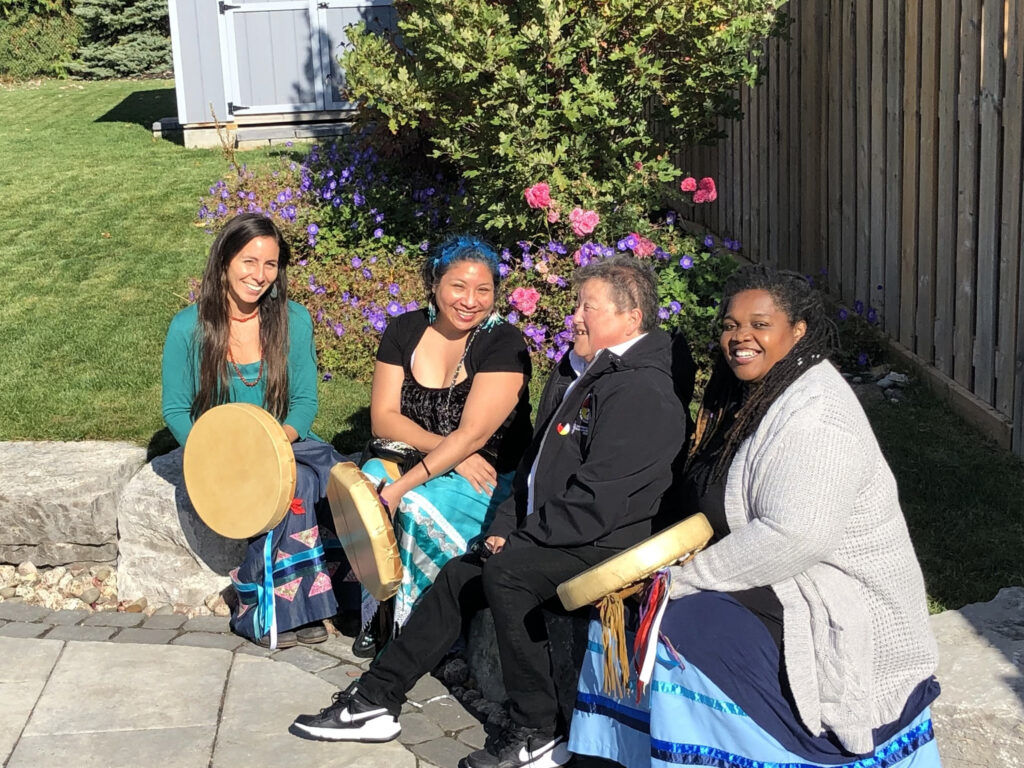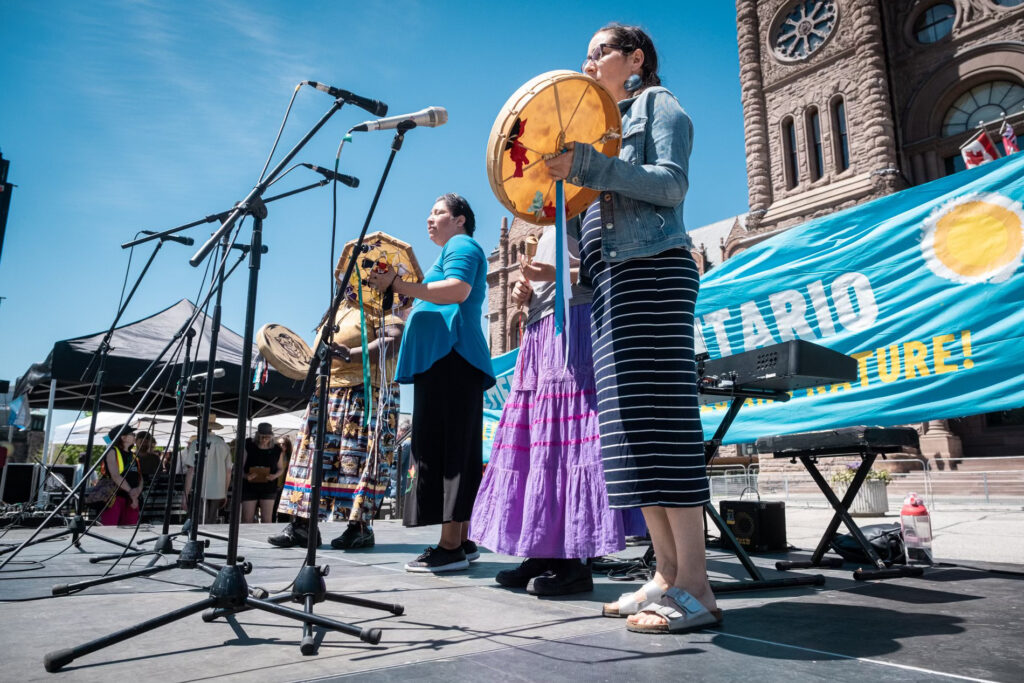By Kassandra Guevara
Listen to this article
At a First Nations drum workshop in 2010, Michele Perpaul found herself in a familiar space, leading another one of her drum circles. Drumming has always been her safe space, a place to disconnect from reality and welcome a connection to her ancestors. Despite considering herself an optimist, she couldn’t shake the disappointment when nobody showed up to her event. In the quiet of the room, she brushed away her discouragement and concentrated on aligning each drum perfectly. As she settled into silent anticipation, she let her hands find their way to the drum, and a song emerged. At that moment, Perpaul felt the healing power wash over her.

Fast forward to the present day, Perpaul is the lead singer of Spirit Wind, a First Nations women’s hand drum group that was established in 1999. For generations, First Nations peoples in Canada have faced cultural disconnection, posing challenges in accessing mental health support. In March, Spirit Wind organized their annual drum circle event at the Waakebiness-Bryce Institute for Indigenous Health at the University of Toronto (U of T) to unite participants in cultural celebration and healing through drumming.
Perpaul extended a warm smile to all who joined. People from all walks of life joined, students, friends, and newcomers alike, were welcomed with genuine warmth. The turnout was so impressive that she and her other group members scattered to grab extra chairs for everyone.
As the event began, each participant was given a drum while settling into their seat. Immediately, everyone admired the craftsmanship of the drums. Some participants ran their fingers over the smooth stretched animal hides that make the drum while others took pictures of the colourful drum that lay on their lap.
Within the drum circle, Perpaul extended a warm invitation for everyone to ask questions, participate in the singing, and, above all, to observe. “Every individual held a unique role,” Perpaul emphasized, “and it was the collective effort that paved the way for each person to unfold their narrative.”
Drumming has been long recognized as a healing practice for Indigenous Peoples. According to an article in TBS news watch, Indigenous culture and tradition believe that the rhythm facilitates healing and realignment of the four realms of human existence: mental, spiritual, emotional, and physical because it is believed that the creator revolves around the rhythm of the drum. A study in the Journal of Indigenous Wellbeing, Creative Arts, Culture, and Healing, highlights the cognitive benefits of drumming. The study emphasizes how creative arts, culture, and healing are interconnected. The data found within the study showcases 69 per cent of Indigenous Peoples within Canada find drumming to have many health-promoting benefits. Responses were received from First Nations, Inuit, and Métis organizations and communities, as well as from Aboriginal healing projects operating in urban centres located across the country.
Perpaul leads the Spirit Wind drum circle with a sense of pride and purpose. Her dedication to drumming resonates with other Spirit Wind members like Amy Desjarlais, who has spent much of her life finding strength and resilience in the rhythm of the drums.
Desjarlais transported herself to her childhood days, where stares from classmates, and curious glances at her long hair, and the unique jewelry she wore – jewelry that you couldn’t find just anywhere. Back then, she didn’t comprehend the judgment she faced or why her identity felt like a target.
“When you’re filled up with all kinds of things that aren’t very nice about you – like Indigenous Peoples have been in this country – you can imagine [yourself as a glass] being filled with the dark sandy bits people look over. That’s all we knew. That’s all we felt about ourselves for hundreds of years,” she said, sending her gaze towards the drum as she fidgets with her fingers.
But now, as Desjarlais sits behind the drums, she imagines herself “spitting out those black things into the middle of the circle,” releasing the pain and trauma that has plagued her for so long.

Similarly, Michael Brown, a research officer and cultural and event coordinator at the U of T Waakebiness Institute for Indigenous Health, finds solace and healing in drumming.
For Brown, drumming was the stepping stone in embracing his Indigenous culture. Sitting in the circle, he moved his fingers over the drum confidently while singing. In this moment, it became clear that his confidence had come a long way from his childhood experiences.
Growing up, the teachings of the Catholic faith shaped Brown’s world. He faced challenges and obstacles that made him doubt himself and his cultural identity. “My dad is from Stó:lō Nation, and my mom is Métis and Icelandic, but I wasn’t raised in the Indigenous culture,” he said.
Brown discovered his passion for drumming during his time at the Waakebiness Institute for Indigenous Health. Being surrounded by his cultural heritage, Brown found the inspiration to embark on his journey to cultural reconnection. “Since becoming my own person, I’ve been doing a lot of decolonization work, and I’ve thrown myself into the thralls of Anishinaabe ceremonies, and it’s been the most rewarding thing to be a part of it all.”
Jenniffer Hammond is a community health navigator at the Native Canadian Centre of Toronto. The lines etched on her face whispered tales of resilience, marking her journey towards self-discovery. Hammond recalled the challenges of growing up disconnected from her traditional Anishinaabe community.
Living in the bustling city of Toronto, far from her ancestral home, Hammond found herself adrift, lacking the guidance that shaped her identity. “It challenged a lot of my upbringing, and, you know, I ended up getting into trouble and using substances and drinking a lot,” she said.
It wasn’t until she was an adult that she grasped the depth of her cultural disconnection she felt as a child. “We don’t really have any guidance in who we are and connection in that way,” she said, recalling a time when she didn’t have access to the kind of treatment and healing she needed.
With time, Hammond found her way back to her roots, embracing her traditional Anishinaabe teachings and language. Now, she said she works tirelessly to bridge the gap between cultural practices and modern urban life, helping individuals connect with their roots and find a sense of identity and belonging.
Perpaul, too, finds that the work she does with Spirit Wind is an achievement unlike any other. She has led initiatives that she never imagined would reach so many people through her drumming. These include performances at events like the climate emergency rally in downtown Toronto, the Canadian Ethnic Media Association (CEMA) Awards, York University Powwows, and numerous others.
“When we sit in a drum circle, there isn’t an expectation of getting all the vocables’ hey’s and ho’s in the right place. It is more about the gathering as community and healing work of the drum,” said Perpaul.
In the closing moments of the drum circle event, Perpaul and her group shared a laughter that radiated warmth throughout the room. Though the source of amusement remained a mystery, its contagious joy enveloped the entire circle. As the energy settled, Perpaul began to sing her ‘All Here’ song, accompanied by the gentle rhythms of the drums, filling the space with soothing melodies. The song, designed to uplift and heal, carried the group through this final experience, leaving behind a lingering sense of hope for all.
Before she set her eyes on the drum that healed her and many other First Nations people, she shared some final words with the group.
“Every song is specific, and every song’s story is beautiful. It has a way of being able to open you in a way that you couldn’t do on your own, and when you’re singing, you don’t even realize you’re doing it, so keep drumming and let it heal you.”
